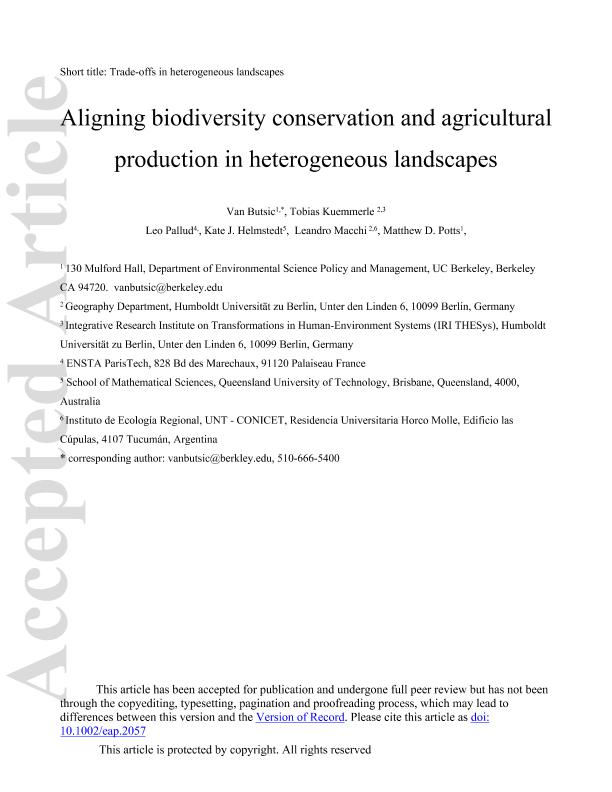Mostrar el registro sencillo del ítem
dc.contributor.author
Butsic, Van
dc.contributor.author
Kuemmerle, Tobias

dc.contributor.author
Pallud, Leo
dc.contributor.author
Helmstedt, Kate J.
dc.contributor.author
Macchi, Leandro

dc.contributor.author
Potts, Matthew D.
dc.date.available
2021-12-07T17:36:26Z
dc.date.issued
2020-04-14
dc.identifier.citation
Butsic, Van; Kuemmerle, Tobias; Pallud, Leo; Helmstedt, Kate J.; Macchi, Leandro; et al.; Aligning biodiversity conservation and agricultural production in heterogeneous landscapes; Ecological Society of America; Ecological Applications; 30; 3; 14-4-2020; 1-32
dc.identifier.issn
1051-0761
dc.identifier.uri
http://hdl.handle.net/11336/148407
dc.description.abstract
Understanding the trade-offs between biodiversity conservation and agricultural production has become a fundamental question in sustainability science. Substantial research has focused on how species’ populations respond to agricultural intensification, with the goal to understand whether conservation policies that spatially separate agriculture and conservation or, alternatively, integrate the two are more beneficial. Spatial heterogeneity in both species abundance and agricultural productivity have been largely left out of this discussion, although these patterns are ubiquitous from local to global scales due to varying land capacity. Here, we address the question of how to align agricultural production and biodiversity conservation in heterogeneous landscapes. Using model simulations of species abundance and agricultural yields, we show that trade-offs between agricultural production and species’ abundance can be reduced by minimizing the cost (in terms of species abundance) of agricultural production. We find that when species’ abundance and agricultural yields vary across landscapes, the optimal strategy to minimize trade-offs is rarely pure land sparing or land sharing. Instead, landscapes that combine elements of both strategies are optimal. Additionally, we show how the reference population of a species is defined has important influences on optimization results. Our findings suggest that in the real world, understanding the impact of heterogeneous land capacity on biodiversity and agricultural production is crucial to designing multi-use landscapes that jointly maximize conservation and agricultural benefits.
dc.format
application/pdf
dc.language.iso
eng
dc.publisher
Ecological Society of America

dc.rights
info:eu-repo/semantics/openAccess
dc.rights.uri
https://creativecommons.org/licenses/by-nc-nd/2.5/ar/
dc.subject
CONSERVATION
dc.subject
LAND SHARING
dc.subject
LAND SPARING
dc.subject
OPTIMIZATION
dc.subject
SPATIAL HETEROGENEITY
dc.subject
TRADE-OFFS
dc.subject.classification
Otras Ciencias de la Tierra y relacionadas con el Medio Ambiente

dc.subject.classification
Ciencias de la Tierra y relacionadas con el Medio Ambiente

dc.subject.classification
CIENCIAS NATURALES Y EXACTAS

dc.title
Aligning biodiversity conservation and agricultural production in heterogeneous landscapes
dc.type
info:eu-repo/semantics/article
dc.type
info:ar-repo/semantics/artículo
dc.type
info:eu-repo/semantics/publishedVersion
dc.date.updated
2021-09-07T14:30:56Z
dc.journal.volume
30
dc.journal.number
3
dc.journal.pagination
1-32
dc.journal.pais
Estados Unidos

dc.description.fil
Fil: Butsic, Van. University of California at Berkeley; Estados Unidos. Berkeley University; Estados Unidos
dc.description.fil
Fil: Kuemmerle, Tobias. Universität zu Berlin; Alemania
dc.description.fil
Fil: Pallud, Leo. ENSTA ParisTech; Francia
dc.description.fil
Fil: Helmstedt, Kate J.. Queensland University of Technology; Australia
dc.description.fil
Fil: Macchi, Leandro. Universidad Nacional de Tucumán. Instituto de Ecología Regional. Consejo Nacional de Investigaciones Científicas y Técnicas. Centro Científico Tecnológico Conicet - Tucumán. Instituto de Ecología Regional; Argentina. Universität zu Berlin; Alemania
dc.description.fil
Fil: Potts, Matthew D.. University of California at Berkeley; Estados Unidos
dc.journal.title
Ecological Applications

dc.relation.alternativeid
info:eu-repo/semantics/altIdentifier/doi/http://dx.doi.org/10.1002/eap.2057
dc.relation.alternativeid
info:eu-repo/semantics/altIdentifier/url/https://esajournals.onlinelibrary.wiley.com/doi/10.1002/eap.2057
Archivos asociados
